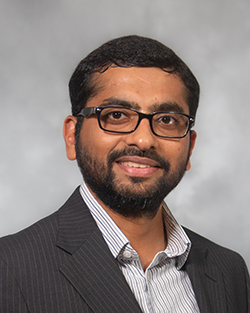People
We are now accepting applications for the 2023 summer program titled ‘Neuromotor Skill Advancement for Post baccalaureates (NSAP)’ at the University of Houston. This program is funded by the National Institutes of Health Eunice Kennedy Shriver National Institute of Child Health and Human Development (NIH/NICHD) R25HD106896. The summer program is a collaboration between CLASS and Cullen CoE. For more information and to apply, please visit the NSAP website - https://www.egr.uh.edu/nsap
Research Interests
My research is primarily focused on understanding the sensorimotor mechanisms for motor control and learning in healthy young individuals, older adults, and patients with neurological diseases and injury. I am also interested in developing therapeutic strategies to improve sensorimotor function in older adults and patient populations. My current research uses the human hand as a model to accomplish these goals. We use a wide range of approaches including motion tracking, kinetic measurements, surface electromyography (muscle activity), transcranial magnetic stimulation (TMS), and transcranial direct current stimulation (tDCS).
Recent Publications and Research Activity
Rao N, Mehta N, Patel P, Parikh PJ. Modulation of Digit Position based on Explicit Cues about Object Property for Dexterous Manipulation is affected in Old Age. (under revision).
Rao N, Mehta N, Patel P, Parikh PJ (2020). Modulation of Grasp Parameters using Arbitrary Cues about Object Property in Older Adults. bioRxiv. https://doi.org/10.1101/2020.10.19.344457.
Young DR, Parikh PJ, Layne CS (2020b). The posterior parietal cortex is involved in gait adaptation: A bilateral transcranial direct current stimulation study. Frontiers in Human Neuroscience. https://doi.org/10.3389/fnhum.2020.581026
Young DR, Parikh PJ, Layne CS (2020a). Non-invasive brain stimulation of the posterior parietal cortex alters postural adaptation. Frontiers in Human Neuroscience. https://doi.org/10.3389/fnhum.2020.00248.
Rao N, Chen Y, Ramirez R, Tran J, Li S, and Parikh PJ (2020). Time-course of Pain Threshold after Continuous Theta Burst Stimulation of Primary Somatosensory Cortex in Pain-free Subjects. Neuroscience Letters. (23)722:134760. doi: 10.1016/j.neulet.2020.134760.
Parikh PJ, Fine JM, Santello M (2019). Dexterous object manipulation requires context-dependent sensorimotor cortical interactions in humans. Cerebral Cortex. 30(5):3087–3101. https://doi.org/10.1093/cercor/bhz296.
Rao N and Parikh PJ (2019). Fluctuations in Human Corticospinal Activity Prior to Grasp. Frontiers in Systems Neuroscience. 13. doi=10.3389/fnsys.2019.00077.
Paek A, Gailey A, Parikh PJ, Santello M, Contreras-Vidal J (2019). Regression-based reconstruction of human grip force trajectories with noninvasive scalp electroencephalography. Journal of Neural Engineering. 16(6):06603. doi: 10.1088/1741-2552/ab4063.
Goel R, Nakagome S (co-first author), Rao N, Paloski W, Contreras-Vidal J, Parikh PJ (2019). Fronto-parietal brain areas contribute to the online control of posture during a continuous balance task. Neuroscience. (413):135-153. doi: 10.1016/j.neuroscience.2019.05.063.
Davare M, Parikh PJ (co-first author), Santello M (2019). Sensorimotor uncertainty modulates corticospinal excitability during skilled object manipulation. Journal of Neurophysiology. 121(4):1162-1170. doi: 10.1152/jn.00800.2018.
Goel R, Ozdemir RA, Nakagome S, Contreras-Vidal JL, Paloski WH, Parikh PJ (2018). Effects of speed and direction of perturbation on electroencephalographic and balance responses. Experimental Brain Research. (236):2073–83. doi: 10.1007/s00221-018-5284-5.
Parikh PJ and Santello M (2017). Role of human dorsal premotor region in learning a conditional visuomotor task. Journal of Neurophysiology. 117(1):445-456. doi: 10.1152/jn.00658.2016.
Parikh PJ and Cole KJ (2016). Editorial - Effects of Aging: A Hand at Work. Frontiers in Aging Neuroscience. 8; 141. doi: 10.3389/fnagi.2016.00141.
Paek A, Gailey A, Parikh PJ, Santello M, Contreras-Vidal J (2015). Predicting Hand Forces from Scalp Electroencephalography During Isometric Grip and Object Grasping. IEEE Engineering in Medicine and Biology Society. 7570-3. doi: 10.1109/EMBC.2015.7320144.
Parikh PJ and Cole KJ (2015). Effects of transcranial direct current stimulation on the control of finger force during dexterous manipulation in healthy older adults. PLOS One. 10(4): e0124137. doi:10.1371/journal.pone.0124137.
Parikh PJ, Davare M, McGurrin P, Santello M (2014). Corticospinal excitability underlying digit force planning for grasping in humans. Journal of Neurophysiology. 111(12):2560-9. DOI: 10.1152/jn.00815.2013.
Parikh PJ, Cole KJ (2014). Effects of transcranial direct current stimulation in combination with motor practice on dexterous grasping and manipulation in healthy older adults. Physiological Reports. 2(3), DOI: 10.1002/phy2.255.
Parikh PJ, Cole KJ (2013). Transfer of learning between hands to handle a novel object in old age. Experimental Brain Research. 227(1):9-18. DOI: 10.1007/s00221-013-3451-2.
Parikh PJ, Cole KJ (2012). Handling objects in old age: forces and moments acting on the object. Journal of Applied Physiology. 112 (7):1095-104. DOI: 10.1152/japplphysiol.01385.2011.
Selected for an editorial review. Latash and Johnston (2012). Why did grandpa drop the glass? Journal of Applied Physiology. 112: 1093-1094.
Parikh PJ, Cole KJ (2011). Limited persistence of the sensorimotor memory when transferred across prehension tasks. Neuroscience Letters. 494(2):94-8. DOI: 10.1016/j.neulet.2011.02.066.
Paek A, Parikh PJ, Gailey A, Santello M, Contreras-Vidal J (2015). Predicting Hand Forces from Scalp Electroencephalography During Isometric Grip and Object Grasping. International Graphonomics Society (IGS 2015).
Jing X, Parikh PJ, Yuan L, Trudeau M, Dennerlein JT, Buchholz B (2009). Biomechanical evaluation of the air stretcher as an alternative for the carpet knee kicker. Proceedings of the 17th World Congress on Ergonomics (IEA 2009), Beijing, China. This work was peer-reviewed.
Education
Bachelor of Medicine and Bachelor of Surgery (M.B.B.S.) at M. S. University of Baroda, Vadodara, Gujarat, India, 2005
M.S. in Biomedical Engineering/Biotechnology with a focus on Biomechanics at University of Massachusetts, Lowell, MA., 2008
Ph.D. in Integrative Physiology with a focus on Human Motor Control/Neuroscience at University of Iowa, Iowa City, IA., 2012
Postdoctoral training in Neuroscience at Arizona State University, Tempe, AZ., 2015
